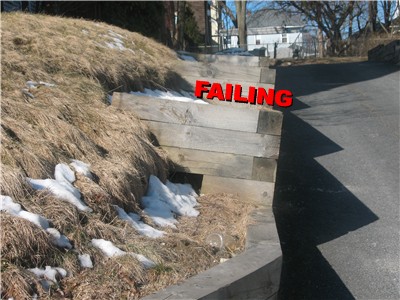Massachusetts Home Inspections YOUR INVESTMENT IS MY CONCERN

Retaining Walls
There are many different materials that are utilized for retaining walls. Builders use a variety of landscape stone, fieldstone, ledge rock, brick, poured concrete, concrete blocks and railroad ties. Most of these retaining walls provide support for soil that is on a vertical slope. Most retaining walls literally keep your home and the surrounding landscape from sliding down a hillside and into your home. Other times retaining walls are necessary to prevent drainage or erosion problems. For whatever purpose these retaining walls are serving, these special structures are relatively expensive and deserve careful attention to protect your initial investment. Retaining walls should be carefully inspected periodically, for shifting, displacement, bulges, leaning or loose structural material. If you notice that your wall has loose material, or cavities that could cause loose material, I highly recommend that you or a professional Contractor repair or reinforce these areas right away, before the wall worsens. Once a wall is compromised or is allowed to worsen, your expenses to repair the much needed wall will be exorbitant.
Make sure that all the lower footings are protected from erosion. Look for weep holes at the lower outside portion of your retaining wall. Weep holes are exposed holes (on the face of the wall) that contain pipes that penetrate the retaining wall and assist in draining the water from the area immediately behind the retaining wall. Weep holes should have a minimum diameter so as to permit free drainage; for large walls, 4-inch weep holes are common. Adequate spacing between the weep holes allows a uniform drainage from behind the wall. At times, perforated drainage pipes are wrapped in geotextile material or buried in a granular filter bed, and serve to convey water to the weep holes from areas deeper within the back-fill. If your property has solid walls and weep holes are not visible, I highly recommend that you have a professional landscaper install these as soon as possible to prevent water retention which in turn, causes serious heaving, displacement and leaning of the wall.
If your property has the landscape timber walls (railroad ties, as pictured above), I recommend that you probe these walls periodically for hollow areas. Carpenter Ants tend ruin these walls over the years and require replacement because they become hollow and very weak. If you want your wood retaining wall to last forever, it's always good to have these wood retaining wall areas professionally treated for Carpenter Ants to prevent any infestation.
If you are planning to replace a wood retaining wall, I recommend replacing the material with landscape stone, brick or other masonry material for a longer lasting wall.
A retaining wall that does not weep water and is not maintained properly, could become one costly upgrade in the future.

MY RETAINING WALL DEFECTS ARE POSTED ON FACEBOOK...
Here is what my clients have to say about my home inspection services:
Press F5 (on your keyboard) for additional testimonials
Hi Dave,
I just wanted to write and thank you very much for doing our inspection today. You really took an awful lot of extra time to explain things to us. It was a huge help and by far my favorite part of this whole home-buying process. In addition to drawing our attention to the major projects that need to be undertaken right away or in the near future, I was glad that you were also so thorough as to point out smaller things and provide suggestions for fixes that we'd be able to do ourselves. Thanks again for all your effort. I'm finding your "Know Your Home" book a great source of information along with your report. I'll no doubt have some questions for you at some point and really appreciate your willingness to answer them. Have a great rest of your weekend!
Take care,
Sean















